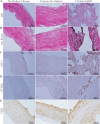Risk factors for radial artery calcification in patients with and without uremia
- PMID: 39799338
- PMCID: PMC11724451
- DOI: 10.1186/s12882-024-03940-0
Risk factors for radial artery calcification in patients with and without uremia
Abstract
Background: Calcification of the radial artery is one of the main causes of anastomotic stenosis in autogenous arteriovenous fistulas in uremic patients. However, the pathogenesis of calcification is still unknown. This study attempted to screen and validate the risk factors for vascular calcification in patients with uremia.
Methods: Serum of blood were collected and tissue samples from radial artery were obtained from 60 uremia patients with or without hemodialysis. General biochemical indicators and calcification-related molecules were collected and detected via ELISA or correlation analysis. In addition, pathological changes and calcification-related molecules in the radial artery were evaluated by HE or immunohistochemical staining.
Results: There were differences in total calcium, calcium-phosphorus products, allograft inflammatory factor 1 (AIF-1), intact parathyroid hormone (iPTH), vitamin D (VD), fibroblast growth factor 23 (FGF23) and soluble klotho (sKlotho) in the blood of uremic patients with or without hemodialysis. Furthermore, these factors are related to calcification of the radial artery. The expression of AIF-1, PTHR1, VDR, FGF23 and sKlotho was also increased in the calcified radial artery.
Conclusions: The levels of AIF-1, PTH, VDR, FGF23 and sKlotho in serum were associated with calcification of the radial artery in patients with uremia. Furthermore, calcification of the radial artery was further aggravated by abnormalities in calcium and phosphorus in maintenance hemodialysis patients.
Keywords: Allograft inflammatory factor 1; Parathyroid hormone; Radial artery calcification; Uremia; Vitamin D.
© 2025. The Author(s).
Conflict of interest statement
Declarations. Ethics approval and consent to participate: This study was carried out in accordance with the Declaration of Helsinki and received ethical approval from the Ethics Committee of the Southern University of Science and Technology Hospital. Informed consent was waived by the Ethics Committee of Southern University of Science and Technology Hospital. Consent for publication: Not applicable. Competing interests: There are no conflicts of interest to declare.
Figures

Similar articles
-
Impact of hepatitis virus infection on arterial calcification among incident hemodialysis patients.Nefrologia (Engl Ed). 2020 May-Jun;40(3):336-344. doi: 10.1016/j.nefro.2019.09.005. Epub 2019 Dec 18. Nefrologia (Engl Ed). 2020. PMID: 31864861 English, Spanish.
-
Histopathological changes of radial artery wall in patients of chronic kidney disease stage 5 undergoing AV fistula formation and their correlation with serum iPTH levels.Saudi J Kidney Dis Transpl. 2015 Sep;26(5):884-9. doi: 10.4103/1319-2442.164562. Saudi J Kidney Dis Transpl. 2015. PMID: 26354558
-
Fibroblast growth factor 23 is not associated with and does not induce arterial calcification.Kidney Int. 2013 Jun;83(6):1159-68. doi: 10.1038/ki.2013.3. Epub 2013 Feb 6. Kidney Int. 2013. PMID: 23389416 Free PMC article.
-
1alpha(OH)D3 One-alpha-hydroxy-cholecalciferol--an active vitamin D analog. Clinical studies on prophylaxis and treatment of secondary hyperparathyroidism in uremic patients on chronic dialysis.Dan Med Bull. 2008 Nov;55(4):186-210. Dan Med Bull. 2008. PMID: 19232159 Review.
-
Vitamin D and type II sodium-dependent phosphate cotransporters.Contrib Nephrol. 2013;180:86-97. doi: 10.1159/000346786. Epub 2013 May 6. Contrib Nephrol. 2013. PMID: 23652552 Review.
References
-
- Kakani E, Elyamny M, Ayach T, et al. Pathogenesis and management of vascular calcification in CKD and dialysis patients. Semin Dial. 2019;32(6):553–61. - PubMed
-
- Ding N, Lv Y, Su H, et al. Vascular calcification in CKD: New insights into its mechanisms. J Cell Physiol. 2023;238(6):1160–82. - PubMed
-
- Goodman WG, Goldin J, Kuizon BD, et al. Coronary-artery calcification in young adults with end-stage renal disease who are undergoing dialysis. N Engl J Med. 2000May 18;342(20):1478–83. - PubMed
MeSH terms
Substances
LinkOut - more resources
Full Text Sources

